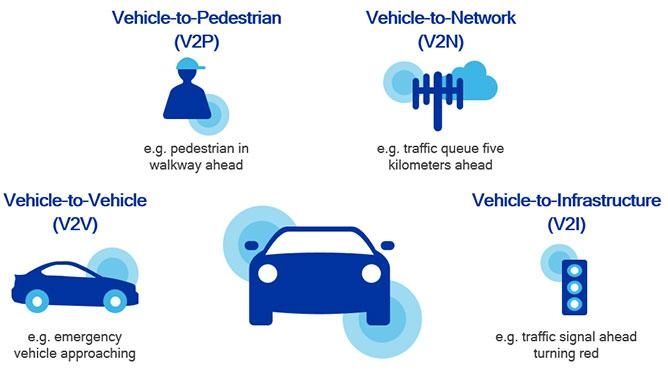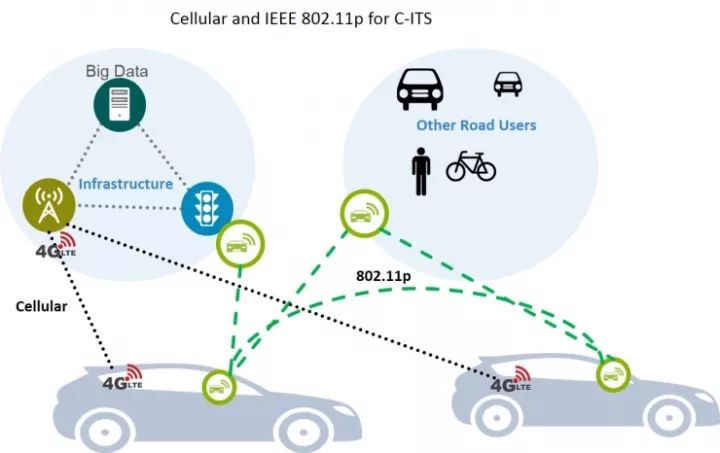To achieve autonomous driving, a vehicle must have a sensing system capable of observing the surrounding environment like a human. However, compared to human perception, autonomous driving requires much more. The observation is not limited to just the front; therefore, in addition to traditional sensors, V2X technology has emerged as a critical component for enhancing situational awareness in self-driving systems. In recent years, the development of V2X technology has been quite promising, and it's now possible to see its mass deployment on roads around the world. This paper provides an overview of the evolution of VRC, DSC, and C-V2X technologies.
V2X, short for "Vehicle-to-Everything," aims to enable information exchange between vehicles and all entities that could affect them—such as other vehicles, infrastructure, pedestrians, and networks. Its primary goals include reducing traffic accidents, easing congestion, lowering environmental pollution, and offering various information services.
The main categories of V2X communication include Vehicle-to-Vehicle (V2V), Vehicle-to-Infrastructure (V2I), Vehicle-to-Network (V2N), and Vehicle-to-Pedestrian (V2P). These interactions allow vehicles to share real-time data about road conditions, potential hazards, and traffic patterns, significantly improving safety and efficiency on the roads.

V2X can be broadly divided into different communication methods. Early V2X solutions were primarily based on DSRC, which stands for Dedicated Short Range Communication. DSRC was developed and tested in the United States for many years. However, with the advancement of cellular communication technology, C-V2X (Cellular V2X) emerged as a new alternative, leveraging existing mobile networks for vehicle connectivity.

**Evolutionary History of V2X Technology**
**(1) Evolution of DSRC Technology**
The U.S. Department of Transportation (USDOT) conducted extensive research from 2004 to 2008 and concluded that V2X systems could reduce up to 4.5 million collision accidents—accounting for 81% of multi-vehicle crashes. As a result, USDOT required automakers to equip future vehicles with DSRC technology by the end of 2019. Over the past decade, DSRC has been extensively tested and refined, making it a mature solution for vehicle communication.
The concept of Intelligent Transportation Systems (ITS) began in the 1950s and 1960s, when highway construction led to increasing traffic problems. By the 1990s, the idea of integrating intelligent systems into transportation gained traction. In 1990, the IVHS (Intelligent Vehicle Highway System) concept was introduced in Dallas, Texas, and later evolved into the broader ITS framework.
In 1991, the ITS concept was included in the Intermodal Surface Transportation Efficiency Act (ISTEA), which allocated $6.6 billion for ITS research over six years. The Automated Highway System project followed in 1992, aiming to develop driverless highways using magnetic markers. This marked one of the first attempts at vehicle-road connectivity.
By 1997, USDOT launched the Intelligent Vehicle Initiative to accelerate the development of collision avoidance systems. In 2003, USDOT allocated 75 MHz of spectrum at 5.9 GHz for DSRC research and initiated the VII project, focusing on V2V and V2I applications.
In 2006, USDOT partnered with major automakers to test V2V and V2I systems. By 2014, the NHTSA proposed FMVSS No. 150, mandating V2V communication in new passenger and light trucks. This effort continued through 2015, with further discussions on the role of V2X in road safety.
DSRC is built upon three key standards: IEEE 1609, SAE J2735/J2945, and IEEE 802.11p. These define the network architecture, message content, and physical communication layers. Unlike Wi-Fi, which uses TCP/IP, DSRC employs WAVE Short Message Protocol for V2V communication, while TCP/IP is used for V2I and V2N.
**(2) Evolution of C-V2X Technology**
With the rise of cellular communication, C-V2X has become a powerful complement to DSRC. Defined by 3GPP, C-V2X includes LTE-based and future 5G systems. It enables V2V, V2I, V2N, and V2P communication using existing cellular infrastructure, offering low latency, high reliability, and scalability.
C-V2X development started in 2015 with 3GPP initiating standardization efforts. Key milestones include the completion of V2V standardization in Release 14, approval of C-V2X in ISO TC 204, and the release of the second phase of C-V2X standards in 2017.
Chinese companies such as Datang, Huawei, and Qualcomm have played leading roles in C-V2X development. Major automakers like Audi, Toyota, and SAIC are also actively testing and deploying the technology. China has allocated specific frequency bands for C-V2X testing, with pilot projects across multiple cities.
C-V2X offers significant advantages over DSRC, including lower deployment costs due to the use of existing cellular networks. With the rollout of 5G in 2020, C-V2X is expected to dominate in China and potentially globally.
**The Future of V2X Technology**
While DSRC remains strong in the U.S. and EU, C-V2X is rapidly catching up. Both technologies may coexist for some time, with each region choosing based on policy, industry support, and infrastructure readiness. In the long run, a new in-vehicle communication protocol may emerge, potentially replacing both DSRC and C-V2X.
As the automotive and communication industries continue to evolve, V2X will play a crucial role in shaping the future of smart mobility and autonomous driving.
*Author: A senior engineer in intelligent driving motion control at a major Chinese automotive technology center.*
Diamond Saw Blade Labeling Machine
Diamond Saw Blade Labeling Machine,Saw Blade Labeling Machine,Labeling Machine For Saw Blade,Customized Labeling Machine
Suzhou Mountain Industrial Control Equipment Co., Ltd , https://www.szmountain.com